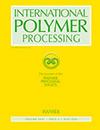Design and manufacture of an additive manufacturing printer based on 3D melt electrospinning writing of polymer
IF 1.1
4区 工程技术
Q4 ENGINEERING, CHEMICAL
引用次数: 1
Abstract
Abstract Objectives Electrospinning is one of the most well-known approaches to producing polymer nanofibers from a polymer solution by applying a potential difference (voltage) between the spinner and the collector, which is used in various industries such as medicine and military. This method has some significant restrictions, like low process efficiency due to the evaporation of the solvent, remaining solvent on the fibers, which are sometimes toxic, and inability to control the geometry of the produced fibers. On the other hand, preparing some solvents used in the electrospinning of polymer solutions is costly. Polymer melt electrospinning writing is a replacement for this type of electrospinning, which can be mentioned in terms of economy, efficiency, and production of solvent-free fibers. Therefore, in this research, a melt polymer electrospinning device was designed and manufactured according to existing extrusion-based additive manufacturing (AM) devices (3D printer). Methods Changes in an extrusion-based 3D printer to convert it into a writing electrospinning device experimentally. Results PLA and PCL fibers with diameters ranging from 8 to 84 μm were produced. The effect of process variables on the produced fibers’ diameter was investigated: Applied potential difference between the nozzle and the substrate: As its increases, the fiber diameter decreases. Increasing temperature: As its increases, the fiber diameter decreases. Distance between the nozzle and the substrate: As its increases, the fiber diameter increases. Flow rate: As its increases, the fiber diameter increases. Conclusions By presenting a 3D printer-electrospinning device, it is possible to control the fiber’s diameter and the 3D geometry in the 3D printing-electrospinning process.基于聚合物三维熔融静电纺丝书写的增材制造打印机的设计与制造
摘要目的静电纺丝是利用纺丝器和集电极之间的电位差(电压)从聚合物溶液中制备聚合物纳米纤维的一种最著名的方法,它被广泛应用于医学和军事等各个行业。这种方法有一些明显的限制,如由于溶剂蒸发导致的工艺效率低,纤维上残留的溶剂有时是有毒的,并且无法控制所生产纤维的几何形状。另一方面,制备一些用于聚合物溶液静电纺丝的溶剂是昂贵的。聚合物熔体静电纺丝书写是这种类型的静电纺丝的替代品,在经济、效率和生产无溶剂纤维方面都可以提到。因此,本研究在现有的基于挤压的增材制造(AM)设备(3D打印机)的基础上,设计并制造了熔融聚合物静电纺丝装置。方法对挤压式3D打印机进行改造,将其转化为书写式静电纺丝装置。结果制备出直径为8 ~ 84 μm的PLA和PCL纤维。研究了工艺变量对纤维直径的影响:喷嘴与基体之间的外加电位差:随着电位差的增大,纤维直径减小。温度升高:随着温度的升高,纤维直径减小。喷嘴与基材之间的距离:随着距离的增加,纤维直径也随之增加。流量:随着流量的增大,纤维直径增大。结论通过3D打印-静电纺丝装置,实现了3D打印-静电纺丝过程中纤维直径和三维几何形状的控制。
本文章由计算机程序翻译,如有差异,请以英文原文为准。
求助全文
约1分钟内获得全文
求助全文
来源期刊

International Polymer Processing
工程技术-高分子科学
CiteScore
2.20
自引率
7.70%
发文量
62
审稿时长
6 months
期刊介绍:
International Polymer Processing offers original research contributions, invited review papers and recent technological developments in processing thermoplastics, thermosets, elastomers and fibers as well as polymer reaction engineering. For more than 25 years International Polymer Processing, the journal of the Polymer Processing Society, provides strictly peer-reviewed, high-quality articles and rapid communications from the leading experts around the world.
 求助内容:
求助内容: 应助结果提醒方式:
应助结果提醒方式:


